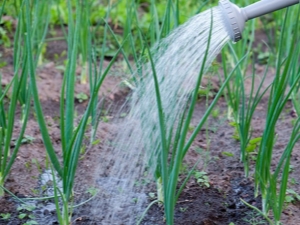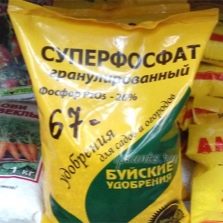Rules for watering onions with salt

When growing onions, even experienced gardeners may face a number of troubles, such as wilting and yellowing of feathers.Some believe that the reason for this may be a rather dry air of the environment or, conversely, an excess of moisture, but, as a rule, the onion fly larvae are to blame. It is very important to take appropriate measures in time, otherwise a large part of the crop may die. There are ways to deal with them and, fortunately, in this situation, you can do without chemical treatment.
Signs of pest damage
Onion flies are small insects reaching sizes of 7 mm. These pests lay the larvae near planted onions or garlic; it is they who harm the plant. Look like this: white small worms about 10 millimeters long. They feed on the pulp of the bulb, being inside it.
One of the first signs is the yellowing of onion feathers. In the future, if you do not carry out competent processing of beds, the following signs appear:
- reduced growth of onion heads;
- feathers become lethargic, faded in color;
- onions themselves are visible lesions, they are soft, and there may be an unpleasant smell.
Saline treatment
This method of pest control is the oldest and most reliable. This folk method is preferred by all gardeners to chemistry due to the fact that onion heads very actively accumulate harmful substances (including nitrates), and preserving the harvest is important not only healthy but also tasty and healthy.
Watering must be done to prevent and control flies. In the second case, you can save even a grown onion. For the purposes of prophylaxis, watering with a solution is necessary when about 3-5 full sheets are formed on the plants. But It is worth noting that the excessive content of salt in the soil adversely affects the growth of onions. The fact is that sodium and chlorine contained in salt wash calcium out of the soil, and it, as we know, is vital for plants.
The chemical composition of the soil also needs to be considered, it can vary considerably in regions. In some cases, watering the solution will simply be necessary to enrich the soil. That is why you need to be careful with salt watering.
Proportions
This solution is prepared quite simply, and the proportions are easy to remember. For cooking using ordinary table salt and running water. To achieve the best effect, watering is done several times, and the proportions vary slightly with each of them.
Thus, in the first watering 300 grams of salt dissolves in 10 liters of water. To make a second watering 450 grams for the same amount of water. And the last time the weight of salt rises to 600 grams per 10 liters. One bulb will need 250-300 ml of solution. Increasing the amount of active substance should be done in the event that during the inspection there were live pests. To do this, you need to clean up the ground next to one of the affected plants a week after the first use of the solution.
The second watering, in the case of surviving larvae, takes about 2-3 weeks. The third - with an interval of 3 weeks. And the best time of day for this procedure is the evening hours before sunset. In other words, early evening is the most favorable time.
Particular attention should be paid to the fact that the solution does not fall on the feathers of onions, watered with salt water under the root.
And also 4 hours after the treatment with saline solution, it is necessary to water the plants with ordinary tap water. This is necessary in order to wash excess salt from the soil and preserve its fertility. It is worth using this method with additional fertilizing in order to preserve useful substances as much as possible. It can be carried out by several substances.
- Ammonia. Used in a proportion of 3 tablespoons per 10 liters of water. Feeding them immediately after germination.
- Dissolve in 10 liter bucket 2 manganese crystals, ammonium nitrate and table salt in a volume of 1 tablespoon of each substance. This procedure should be carried out about a month after landing.
- And finally fertilizer superphosphate in proportion 2 tablespoons per bucket of water.
These fertilizers are used in small quantities to avoid harming the onions.
Methods of dealing with flies
Experienced agronomists are advised to water the onion with saline and to prevent the appearance of pests. Thus, it is possible to prevent the appearance of onion flies. To do this, it is necessary to follow some rules of planting and care.
- Before planting onions, you must dig up the beds well. This should be done in the fall. It is necessary to repeat the procedure immediately before the plants are planted.
- For onions you need a lot of space, so the beds should be made at a distance of about 20 centimeters from each other.
- The best neighbors for onions are carrots and tomatoes. It is their smell that flies do not tolerate.
- Weeds must be cleaned on time.
- Plant nutrition is also very important.
- The branches from the tomatoes can be laid out around the planted onion, it will scare off pests.
- To loosen the soil around the onion is necessary regularly, because flies do not like this land.
- It is advisable to change the place of planting onions every year for its safety.
- Small plants can be created around the plants.
- Sprinkling the bed with peat will also be a very useful procedure.
To control pests, you can also use the following: mix baking soda and salt in a ratio of 1: 2 and disperse the composition into affected beds.
In general, this method is well suited to those gardeners who are faced with pests in the face of onion flies, but are afraid to use chemicals to combat them. The method is quite effective, especially if all the recommendations are followed, including the correct feeding of plants.
And for those who are still afraid of harming the composition of the soil, using salt water, you can try the following method. Immediately before planting onions, more precisely, 12 hours before, the seedlings are soaked in solution. It is prepared by diluting a glass of salt in a bucket of water. The seedlings are placed in the prepared liquid, thus, the upper shell absorbs enough salt to scare away the larvae of onion flies.
About 10 secrets of productive onions or how to grow a healthy large onion, see the following video.
































